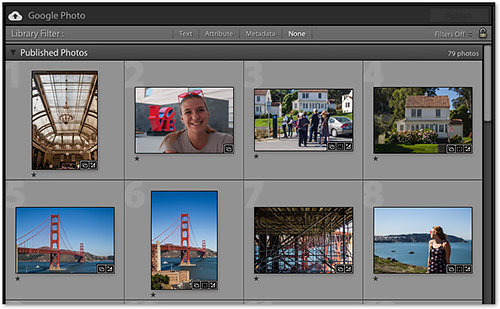Photo Corners headlinesarchivemikepasini.com
![]()
A S C R A P B O O K O F S O L U T I O N S F O R T H E P H O T O G R A P H E R
![]()
Enhancing the enjoyment of taking pictures with news that matters, features that entertain and images that delight. Published frequently.
A Lightroom-Google Photos Plug-In




11 October 2017
There had to be a better way. To move images from Lightroom to Google Photos, which offers free unlimited photo storage and easy photo sharing, we had a simple routine. Export the JPEGs and drag them into the browser window opened to Google Photos.
This works. But sometimes the uploads stall. And it requires local disk space for the exports, which we tend to leave around in case we need them again. So while it works, it isn't elegant.
Luckily for us, London-based Shinji Tanaka had the same problem and the time to resolve it by writing a Lightroom plug-in for Google Photos. In Introducing a New Google Photos Plugin for Lightroom, which he published in February on Medium, he introduced the plug-in to the world.
We downloaded it and gave it a whirl.
INSTALLATION
To install the plug-in, unzip the download and leave it on your Desktop. Then use Lightroom's plug-in manager to add the plug-in to the Lightroom app's plug-in folder (which, as a package, is not usually accessible to mere mortals).
From there, you can enable the plug-in and go through the options to set it up. That includes logging into your account and setting options like file naming, JPEG compression and sharpening.

Settings. We opted for less JPEG compression.
JPEG compression was set ridiculously low (something like 66) so we bumped it up to 85, our minimum.
USING THE PLUG-IN
We had our usual confusion trying to populate a collection for publication to Google Photos. The trick is to 1) create the collection in the Google Photos plug-in and 2) drag the images to it by clicking on the image (not the frame).
Once we did that, we found we had populated our collection with the 80 images we wanted to share.
At the top of the thumbnail display, you'll find a
Publishbutton.The first time we tried that we got an error message about the destination. We took the hint and created an album on Google Photos with the same name as the collection.

Error. Probably related to the deprecated API.
That resolved the error but the images did not actually load into the album on Google Photos. They simply uploaded. We had to manually add them to the album in a separate step.
Still, in worked.
We watched as each image thumbnail moved from the top of the thumbnail display to a lower section marked Published. There was a lot of disk activity at first but then it stopped.

Published. The 'Publish' button is grayed out at the top right and our images are all under the Published banner.
We thought the uploads had stopped too but they hadn't. We monitored the Published section and saw they were continuing to upload.
UPDATING
We'd forgotten about a JPEG on our iPhone we wanted to add to the collection. We imported it into our Collection and edited it in the Develop module.

Publish. The 'Publish' button is active at the top right for our one images above the Published banner. When we clicked on 'Publish' it sent the image to Google Photos.
From the Library module, we dragged the thumbnail to our Google Photos album where it sat in the unpublished pane as shown above until we clicked on the Publish button.
This time, the upload went directly into our Album on Google Photos. Hurray.
NITS TO PICK
It could be smoother, no doubt, but it let us skip the manual method of a JPEG export and manual drag-and-drop upload.

Albums. 'Photos' seems permanently useless.
And it theoretically will keep the collection in sync with the album, so it we edit an image or add one or delete on, we don't have to do any housekeeping. There seems to be some issue with that, though.
There is a default Photos album that holds nothing and can't be deleted. We let it be.
Oh, and it does write a log file in the
~/Documentsfolder, which we find annoying (but DxO does that too).It also uses the deprecated Picasaweb API, which limits you to posting to an album you can't create. We suspect that's where our error came from, although the upload did not end up in the album we created in Google Photos.
Otherwise it seems to solve the problem of getting from Lightroom to Google Photos more efficiently than our old manual method.